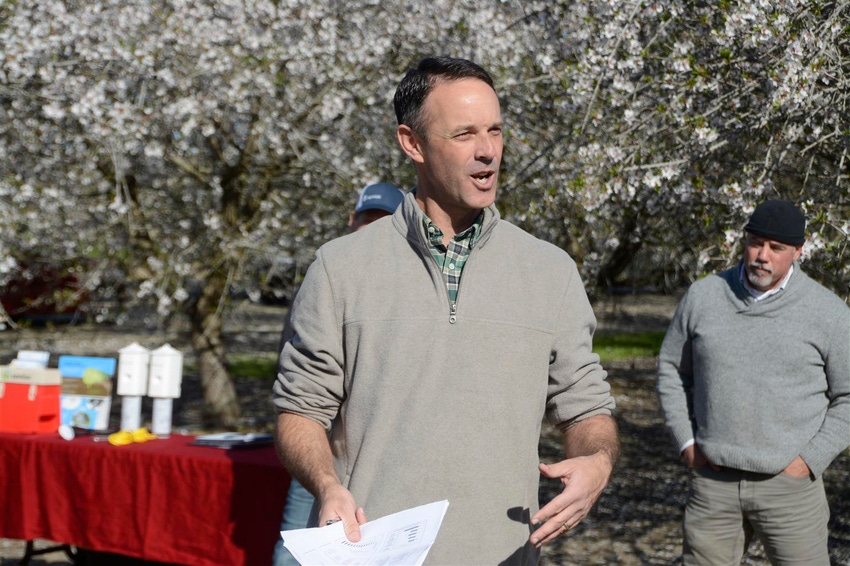
As the volume of high-value crops including pistachios and almonds continues to rise, the importance of controlling Navel orangeworm (NOW) in orchards also increases.
With the addition of mating disruption technology in the last several years to aid in this effort, University of California farm advisors continue to strongly emphasize orchard sanitation practices.
David Haviland, entomologist with the University of California Cooperative Extension in Kern County, says this is the cornerstone of NOW control in pistachios and almonds.
What makes this pest particularly worrisome is it goes after the nut and does not feed on any other part of the tree. Knowing this can make control easier if growers and their pest control advisers employ the proper practices.
Since NOW feeds only on the nut, winter sanitation is crucial in this fight. Removing mummy nuts from the trees and destroying those on the ground are all cost-effective methods in high-value crops including pistachios and almonds, Haviland says.
Speaking to pistachio farmers at the recent American Pistachio Growers annual meeting in Palm Desert, Calif., Haviland pointed to the pest’s association with Aspergillus fungi and aflatoxin contamination which make eliminating the pest even more critical, particularly as production increases.
“Over the last five years, this has been a significant issue within the pistachio industry,” Haviland said.
Winter sanitation in pistachio orchards is as simple as removing all nuts from trees. Whether accomplished through effectively shaking the trees at harvest or following up later with a hand crew using poles to knock down the remaining nuts, moving them to the ground is the first step.
According to Haviland, a second shake in pistachios to yield another hundred pounds of nuts per acre can justify the cost of re-shaking trees when grower prices are at least $2 per pound.
Data show that half the mummy nuts remaining in a tree can have NOW pupae, he says. For those mummy nuts on the ground, data suggest at least 8.5 percent of them can also have worms.
Next, Haviland recommends ensuring there are no nuts are trapped in the tree crotch. Once nuts are on the ground they can be blown off the berms into the center of orchard rows to be plowed into the soil, eventually causing decay.
In years like this with rain and flooding, Haviland says mummy nuts remaining on the orchard floor – particularly where there are weeds or other grassy vegetation – will likely rot, killing overwintering NOW larvae.
As the season progresses, it’s the removal of mummy nuts that become critical as moths in the first and second flights will return to the same mummy nuts to lay their eggs and repopulate.
Moths entering the third flight have it easier as they can access early pistachio splits – if available – or neighboring almonds to lay eggs. This is when good insecticide timing, based on degree-day models, becomes more effective and necessary.
Harvest timing is also crucial in pistachios. Nut removal close to Sept. 1 can help avoid damage in areas where a fourth flight of NOW might occur, which is typically seen in the southern end of the San Joaquin Valley. For growers in those areas, it is critical to harvest nuts as early as possible to avoid damage.
Haviland says research from 2012 and 2013 suggests that NOW damage can double every 10 days after Sept. 1. For example, a Sept. 1 harvest 1 with 1 percent NOW damage can have 2 percent NOW damage by Sept. 10. Wait another 10 days and that damage can double again to 4 percent.
Data shared from research by The Wonderful Company suggests harvest in early September tends to keep NOW damage under 2 percent.
While there are insecticides available for NOW control, Haviland cautions against too many applications, saying “the law of diminishing returns” make fourth and fifth sprays too costly for the benefits gained. Studies suggest that while one spray may achieve 50 percent NOW reduction, two sprays can provide 65 percent reduction, and a third spray upwards of a 70 percent reduction. Sprays beyond this might gain one or two more percentage points.
He also cautions against relying heavily on pyrethroids as resistance to the same active ingredient is beginning to occur.
Haviland says mating disruption is one more tool growers can use to control NOW, though he cautions that this cannot replace or supplant other practices.
“Mating disruption is absolutely not a replacement for sanitation, early harvest or to completely eliminate pesticide use in pistachios,” he said. “It will help with the program, however.”
Several companies currently employ mating disruption technology that dispenses pheromones to fool males into believing females are in the area by mimicking the female's pheromone scent.
About the Author(s)
You May Also Like






